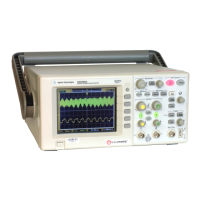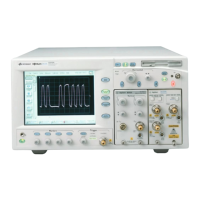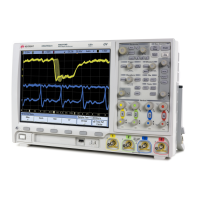I2C/SPI Triggering and Serial Decode 25
Agilent InfiniiVision 3000 X-Series Oscilloscopes User's Guide 385
• Missing Ack — indicated by an "X", highlighted in red if an error.
Aliased data is highlighted in pink. When this happens, decrease the
horizontal time/div setting and run again.
Searching for I2C Data in the Lister
The oscilloscope's search capability lets you search for (and mark) certain
types of I2C data in the Lister. You can use the [Navigate] key and controls
to navigate through the marked rows.
1 With I2C selected as the serial decode mode, press [Search].
2 In the Search Menu, press the Search softkey; then, turn the Entry knob
to select the serial slot (Serial 1 or Serial 2) on which the I2C signal is
being decoded.
3 Press Search; then, select from these options:
• Missing Acknowledge — finds SDA data is high during any Ack SCL
clock bit.
• Address with no Ack — finds when the acknowledge of the selected
address field is false. The R/W bit is ignored.
• Restart — finds when another start condition occurs before a stop
condition.
• EEPROM Data Read — finds EEPROM control byte value 1010xxx on the
SDA line, followed by a Read bit and an Ack bit. It then looks for the
data value and qualifier set by the Data is softkey and the Data
softkeys.
• Frame(Start:Address7:Read:Ack:Data) — finds a read frame on the 17th
clock edge if all bits in the pattern match.
• Frame(Start:Address7:Write:Ack:Data) — finds a write frame on the 17th
clock edge if all bits in the pattern match.
• Frame(Start:Address7:Read:Ack:Data:Ack:Data2) — finds a read frame on
the 26th clock edge if all bits in the pattern match.
• Frame(Start:Address7:Write:Ack:Data:Ack:Data2) — finds a write frame on
the 26th clock edge if all bits in the pattern match.
For more information on searching data, see "Searching Lister Data" on
page 128.
For more information on using the [Navigate] key and controls, see
"Navigating the Time Base" on page 60.

